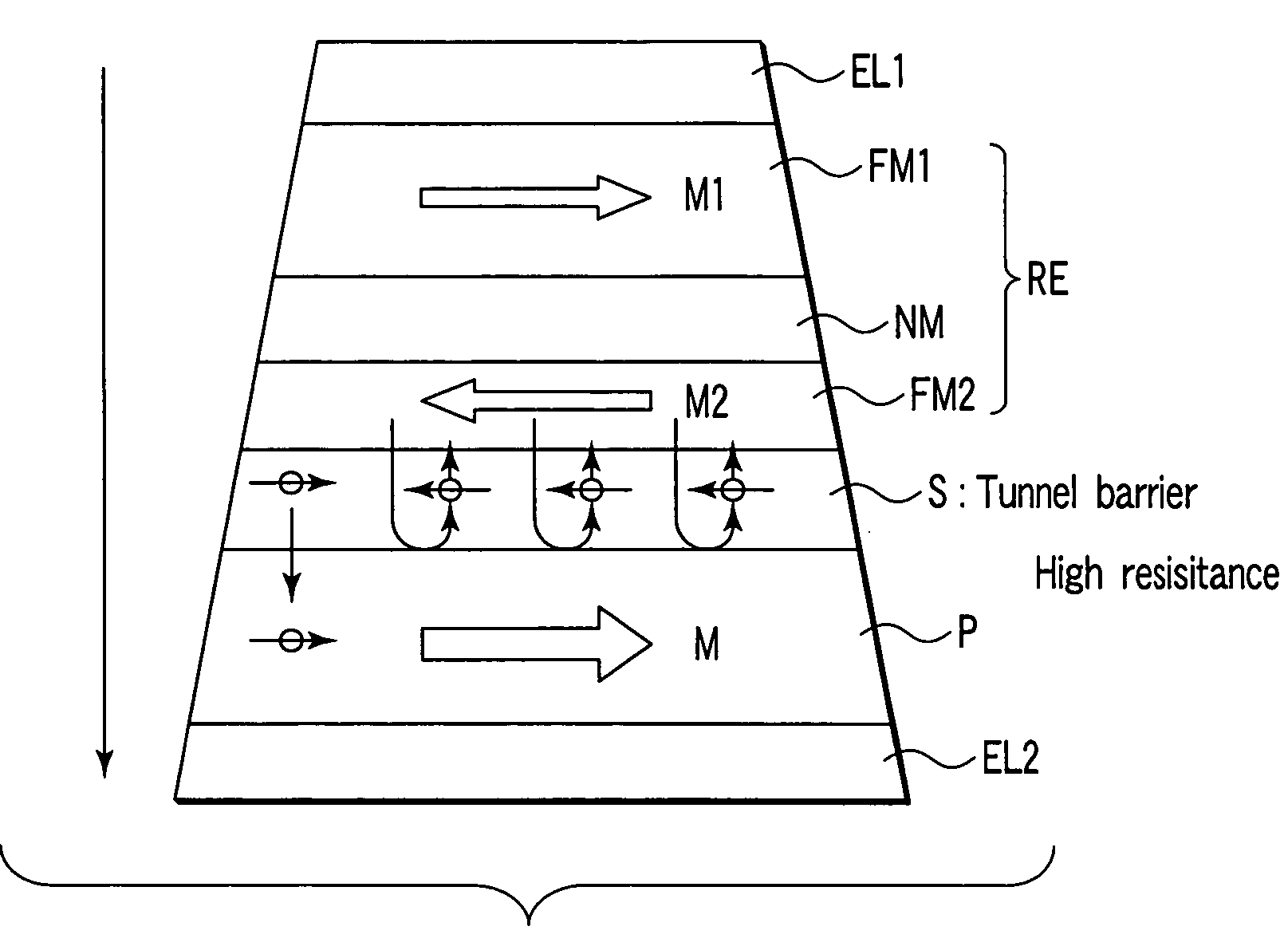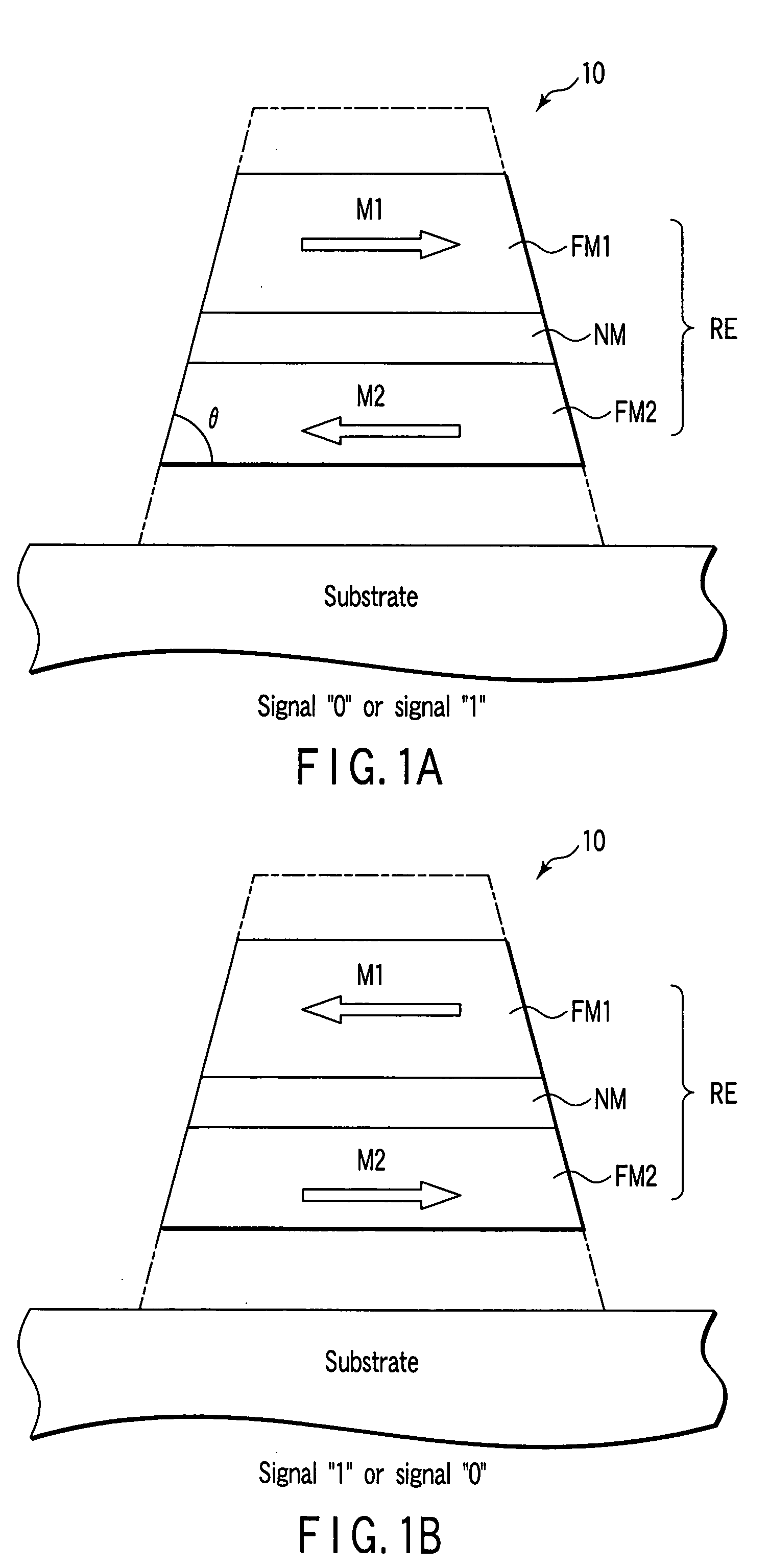Magneto-resistive element
a magnetic memory and magnetoresistive element technology, applied in the field of magnetoresistive elements and magnetic memory, can solve the problems of inability to obtain a sufficiently generated magnetic field, difficult localization, and serious cross-talk problem of adjacent bits or cells affected by the magnetic field
- Summary
- Abstract
- Description
- Claims
- Application Information
AI Technical Summary
Benefits of technology
Problems solved by technology
Method used
Image
Examples
example 1
[0181] In accordance with Example 1, a description will be given with respect to a write characteristic caused by a current charge of the magneto-resistive element according to the invention while comparing it with a write characteristic caused by a current charge of a magneto-resistive element having a free layer composed of a single magnetic layer.
[0182]FIGS. 20A and 20B are schematic views showing a sectional structure of a magneto-resistive element which the Inventor has produced as a prototype. The structure of the thus produced magneto-resistive element is as follows.
(Sample 1)
[0183] Lower electrode / [PtMn 15 nm / CoFe 4 nm / Ru 1 nm / CoFe 4 nm] / Cu 6 nm / [CoFe 1.2 nm / Ru 1 nm / CoFe 1.3 nm]
(Sample 2) [0184] Lower electrode / [PtMn 15 nm / CoFe 4 nm / Ru 1 nm / CoFe 4 nm] / Cu 6 nm / CoFe 2.5 nm
[0185] Sample 1 is provided as a magneto-resistive element in Examples of the present invention, and corresponds to the element illustrated in FIG. 16B. On the other hand, sample 2 is provided as a magn...
example 2
[0208] Now, in accordance with Example 2 of the present invention, a description will be given with respect to a result obtained by prototyping samples when magnetic fixed layers are provided on the top and bottom of the recording section.
[0209]FIGS. 27A and 27B are schematic views showing a sectional structure of a magneto-resistive element prototyped by the Inventor. A structure of the produced magneto-resistive element is as follows.
(Sample 3)
[0210] Lower electrode / [PtMn 15 nm / CoFe 4 nm / Ru 1 nm / CoFe 4 nm] / Al2O3-x 1 nm / [CoFe 1.2 nm / Ru 1 nm / CoFe 1.3 nm / Cu 6 nm / [CoFe 4 nm / Ru 1 nm / CoFe 5 nm / PtMn 15 nm]
(Sample 4) Lower electrode / [PtMn 20 nm / CoFe 20 nm] / Al2O3-x 1 nm / [CoFe 1.2 nm / Ru 1 nm / CoFe 1.3 nm] / Cu 6 nm / [CoFe 6 nm / PtMn 15 nm]
[0211] Samples 3 and 4 correspond to elements illustrated in FIGS. 17B and 18. That is, in sample 3 and sample 4 of this Example, magnetic fixed layers are provided on the top and bottom of the recording section RE, whereby an inversion current is reduced....
example 3
[0217] The thickness of each of the upper and lower magnetic layers configuring the recording section will be discussed in accordance with Example 3 of the present invention. An element having the structure of the invention shown in FIG. 17A in which an angle θ formed by a trapezoidal shape is 45 degrees was fabricated as sample 5. The element structure is as follows.
(Sample 5)
[0218] Lower electrode / [PtMn 15 nm / CoFe 4 nm / Ru 1 nm / CoFe 4 nm] / Al2O3-x 0.7 nm / [CoFe 1.4 nm / Ru 1 nm / CoFe 1.6 nm] / upper electrode
[0219] In addition, sample 4 having the following structure was fabricated as Comparative Example.
(Sample 6)
[0220] Lower electrode / [PtMn 15 nm / CoFe 4 nm / Ru 1 nm / CoFe 4 nm] / Al2O3-x 0.7 nm / [CoFe 1.7 nm / Ru 1 nm / CoFe 1.3 nm] / upper electrode
[0221] Sample 5 was fabricated as follows. After a lower electrode had been formed on a wafer, the wafer was introduced into a ultra-high vacuum sputtering apparatus, and a multilayer film composed of PtMn (20 nm) / CoFe 4 nm / Ru 1 nm / CoFe 4 nm / Al ...
PUM
 Login to View More
Login to View More Abstract
Description
Claims
Application Information
 Login to View More
Login to View More - R&D
- Intellectual Property
- Life Sciences
- Materials
- Tech Scout
- Unparalleled Data Quality
- Higher Quality Content
- 60% Fewer Hallucinations
Browse by: Latest US Patents, China's latest patents, Technical Efficacy Thesaurus, Application Domain, Technology Topic, Popular Technical Reports.
© 2025 PatSnap. All rights reserved.Legal|Privacy policy|Modern Slavery Act Transparency Statement|Sitemap|About US| Contact US: help@patsnap.com



